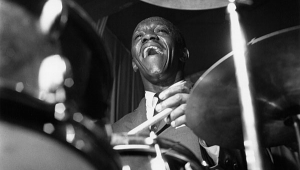| Columns Retired Columns & Blogs |
Intermezzo: The Santa Barbara Sessions Denis Stevens on the Music
Sidebar 2: Denis Stevens on the Music
Johannes Brahms: Piano Sonata in f, Op.5
At the age of 19, Johannes Brahms was steadily putting his life together. For seven years or more he had worked intensively with Eduard Marxsen, a magnificent and munificent piano teacher, hard as nails and sentimental as blazes, pupil of one of Mozart's pupils and well-acquainted with a friend of Schubert and Beethoven. Marxsen never asked his young protégé for a fee, and was like a second father to him.
It was Marxsen who urged Brahms to compose seriously in addition to practicing the piano, and many years later he was rewarded by the dedication of the Second Piano Concerto. But he was already proud of the young Johannes, who at 16 convincingly rattled off Beethoven's "Waldstein" Sonata at a public recital. The point is that Brahms learned from Marxsen not only piano technique but the joy of feeling comfortable in the great classical forms into whose mold he was more than content—at least in his slow movements—to pour the limpid melodies of his native German folksong.
This Third Piano Sonata, which was also to be his last, shows a faint trace of indecision despite the tremendous vigor of the opening movement, the thrust of the Scherzo, and the headlong course of the vociferous and variegated finale. All these were written in November of 1852, in an irresistible rush of youthful enthusiasm. Well, three movements may be enough for a sonata—but what about a slow movement? That, Brahms reasoned, could be added later, and what he eventually decided to do was to use not one but two thematically related movements, written at an earlier date, to set off the ones he had just composed.
If it seems a little odd to put together in this way movements of different vintages, think of a friend who might own two older components—an amplifier and a turntable—which he was unwilling to throw away when he bought a CD player and two new speakers. Three brand-new items linked in harmony with two old favorites: an electronic and economic solution yielding true artistic delight. This is precisely what happened with the three new and two old movements of Op.5.
On meeting the Hungarian violinist Eduard Reményi, the energetic Johannes agreed to go on a concert tour, visiting such cities as Hanover (where they met Joseph Joachim, violinist and composer who was later to influence Brahms considerably) and Weimar, where they encountered Liszt. Later, on his own, Brahms went to Düsseldorf where an introduction to Robert and Clara Schumann changed the whole course of his life. In an article published in the Neue Zeitschrift für Musik, Schumann lavishly praised the fledgling composer "at whose cradle graces and heroes mounted guard."
In Leipzig Brahms played in aristocratic salons such as that of Hedwig Salomon, who wrote in her diary: "There he sat before me, Schumann's young Messiah, fair and delicate; though only in his twentieth year, his face showed the triumph of his spirit. Purity, innocence, naturalness, power and depth—this describes his character."
At another home he was introduced to the Countess Ida von Hohenthal, whose children at that time needed a piano teacher. Since Brahms himself could not oblige, he recommended his brother Fritz, like him a pupil of Marxsen. The Countess accepted, and it was to her, in gratitude, that Brahms dedicated his Sonata.
The slow movement, prefaced by a quotation from the poet Sternau (who supplied a lyric for Brahms's vocal quartet Op.64 No.1), suggests the quintessence of romanticism:
The twilight glimmers, by moonbeams lighted,
Two hearts are there, in love united,
And locked in a blest embrace.
The D-flat coda sounded so good to Wagner that he borrowed it when writing, in Die Meistersinger, Hans Sachs's first monologue: "A right good beak has the bird that sang today." This is the movement whose opening theme of falling thirds prompted the second and shorter Andante, entitled Rückblick, or "Retrospect"—a gentle and nostalgic reminiscence in which, perhaps for the first time in Brahms, orchestral sounds shimmer through the piano texture.
Johannes Brahms: Three Intermezzi, Op.117
Philipp Spitta, the Bach scholar, wrote to Brahms: "Intermezzi are things that by their nature necessarily have antecedents and consequents which every player and hearer must formulate for himself." And just as the earliest intermezzi were plays within plays, so their eponymous musical equivalents often suggest an idea within a frame which we are at liberty to construct. The individual form is always A-B-A.
The first composer to use "Intermezzo" as the title of a miniature was Schumann in his Op.4 (1832), which in an earlier incarnation as Op.3 were called "Pièces Phantastiques." Brahms followed his friend's lead in the Op.76 set of 1878. In the three pieces that make up his Op.117, one finds an effortless inevitability, an aesthetic rightness about his melodies and harmonies. When the tune is in an inner part and the descants take on an almost angelic air, the only thing to do is press the repeat button, by which means each intermezzo has an infinite number of antecedents and consequents.
No.1 in E-flat, the intermezzo featured on this album as an encore, is prefaced by the opening couplet of Lady Anne Bothwell's Lament, an old Scottish ballad, in a translation by Johann Gottfried von Herder:
Schlaf sanft, mein Kind, schlaf sanft und schön!
Mich dauert's sehr, dich weinen sehen.
(Sleep soft, my bairn, now softly sleep!
My heart is wae to see thee weep.)
Brahms used to call this lovely melody "the lullaby of my griefs," and those who know anything of his life will be well aware of the sorrows he had to bear. Yet this is music to soothe all humanity, and has been capable of doing so ever since it first saw the light in 1892.
No.2 in b-flat: Here is a minor-key piece which is far from unhappy, so gracefully do the limpid arpeggios reveal the veiled melodic line.
No.3 in c-sharp: When it first appears, this solemn unison chant gives an impression of bleak, unsheltered mourning, yet as an inner voice it is miraculously transformed by a glowing descant melody.—Denis Stevens
- Log in or register to post comments



































